Abstract
Intrinsic horizontal axon collaterals in the striate cortex of adult cats specifically link columns having the same preferred orientation; consequently, retrograde tracer injections result in intrinsic labeling that is sharply clustered. We have previously shown that the normal development of this circuitry involves the emergence of crude clusters from an unclustered pattern during the second postnatal week. Crude clusters are later refined to the adult level of specificity by the selective rearrangement of axonal arbors that initially project to incorrect orientation columns. Here we report that depriving animals of patterned visual experience by binocular lid suture prior to natural eye opening had no discernible effect on the emergence of crude clusters. In contrast, cluster refinement was dramatically affected by binocular deprivation. Injections of retrograde tracers in the striate cortex of animals binocularly deprived for greater than 1 month revealed only crude clusters, indicating that horizontal axon collaterals projecting to incorrect orientation columns were retained well past the age when they normally would have been eliminated. Layer 2/3 pyramidal cells from 6-week-old binocularly deprived animals had abnormal distributions of intrinsic horizontal axon collaterals that mirrored the lack of cluster refinement. The radial clustering of their horizontal collaterals was considerably less precise than normal. These cells, nevertheless, developed many of the features of normal mature arbors, including the distal axonal branches not seen in arbors from younger animals with normal visual experience. Together, these results indicate that axonal rearrangements occurred, but with reduced specificity. Thus, binocular deprivation did not simply arrest the development of this orientation-specific circuit at an immature state but limited the accuracy with which axon collaterals were added or eliminated. We suggest that development of this orientation-specific circuitry, like ocular dominance column segregation, may depend on temporal correlation of activity for regulation of axonal rearrangement. The specificity of rearrangement may be degraded in binocularly deprived cats because they do not experience sharply oriented visual stimuli necessary for concurrent activation of same-orientation columns.
Full text
PDF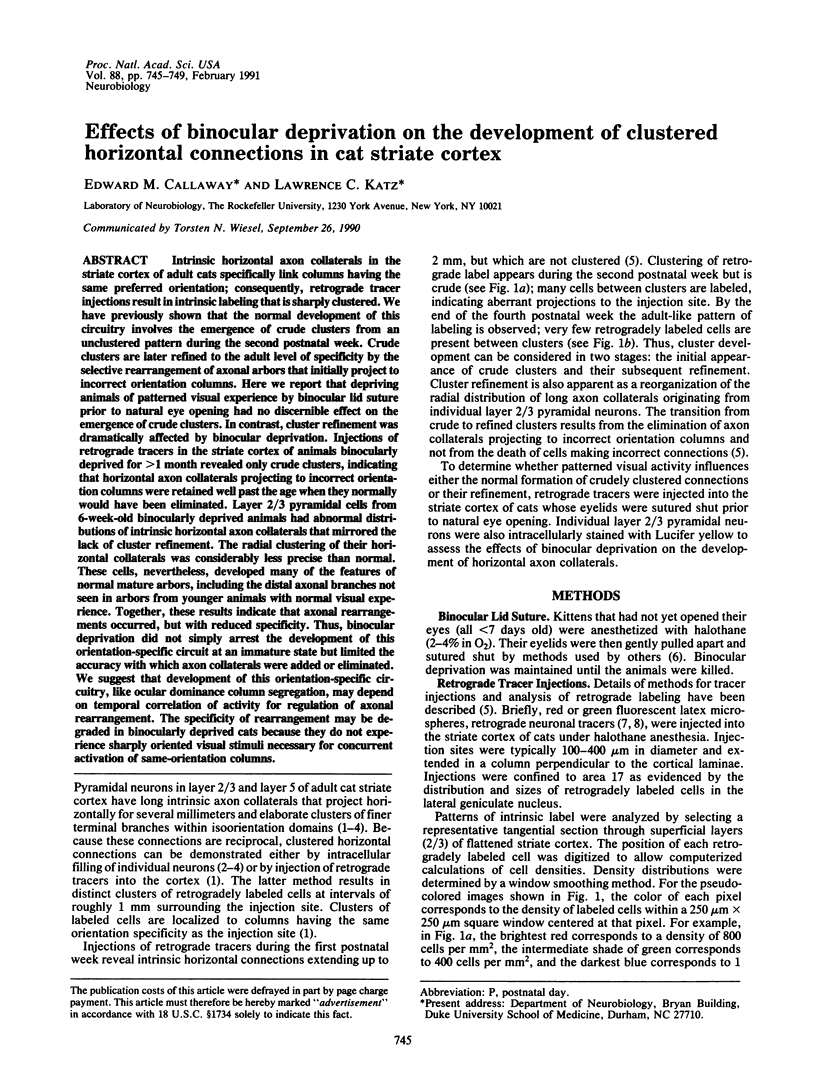
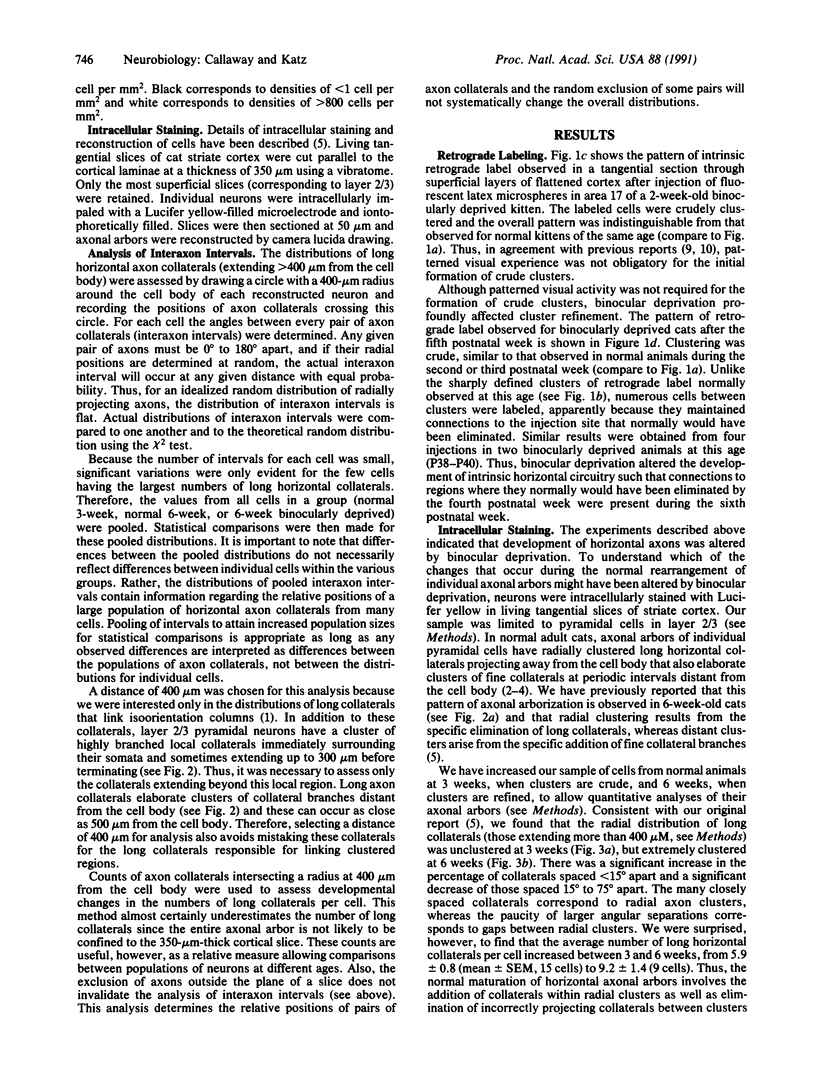
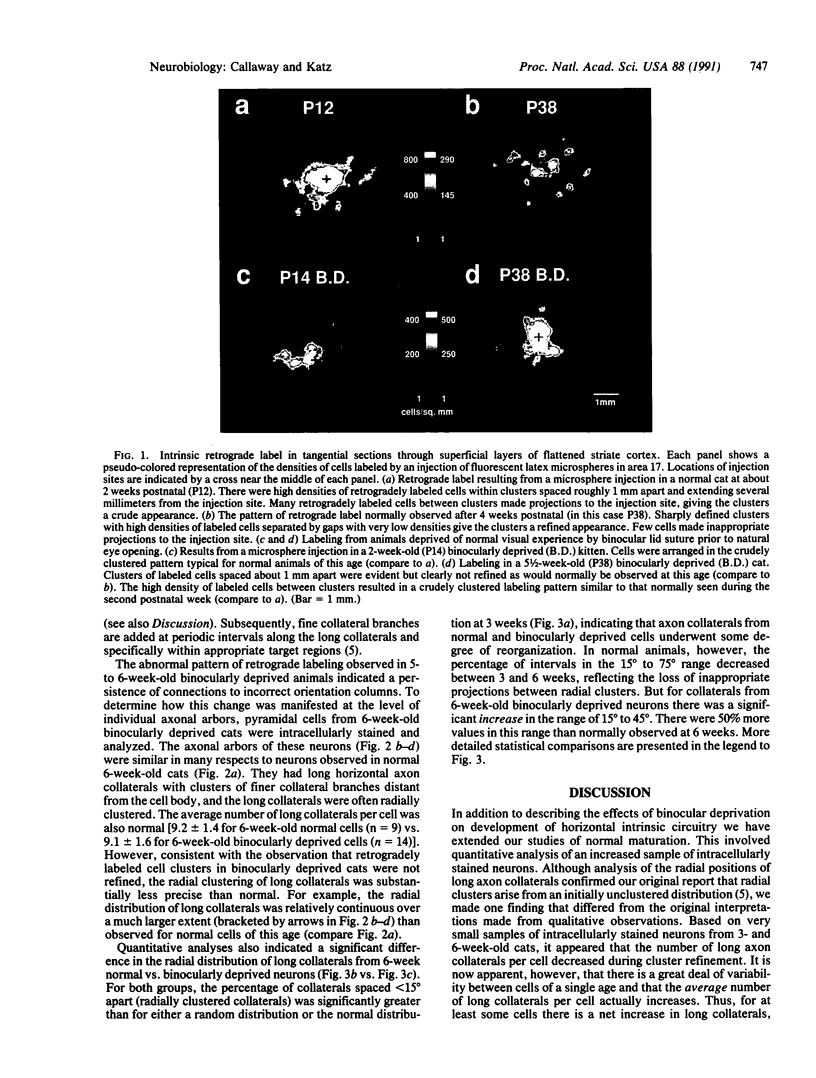
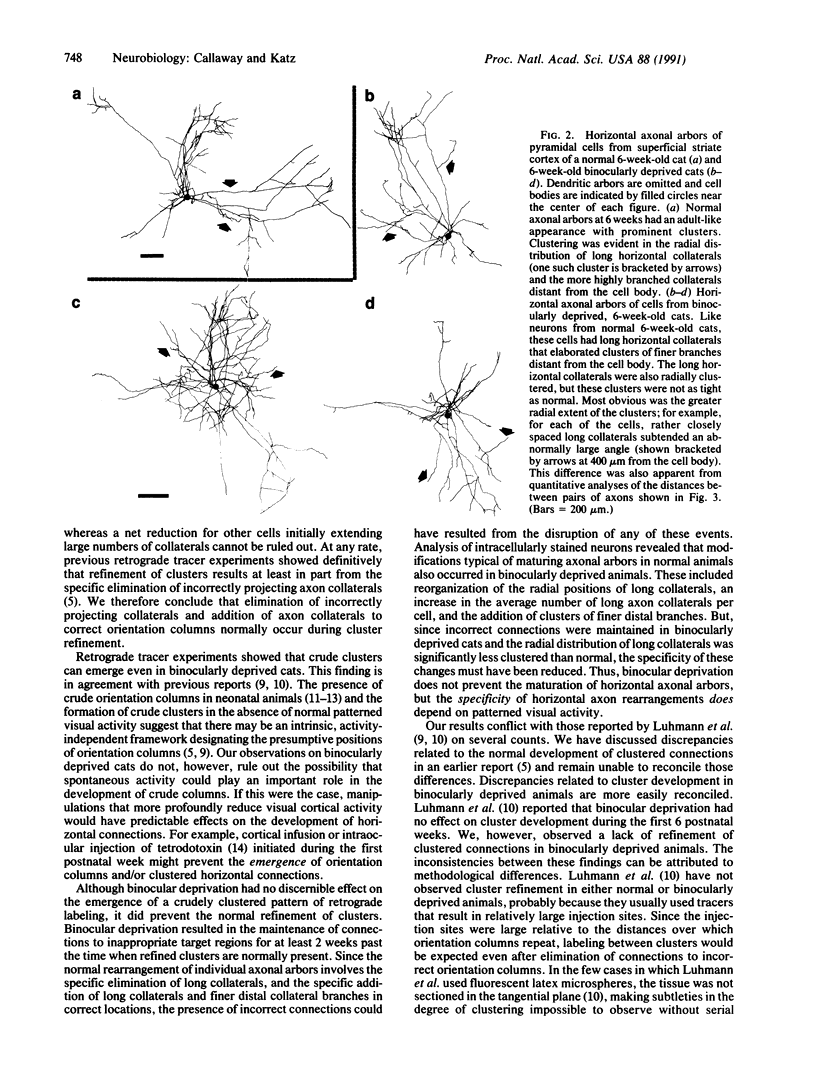
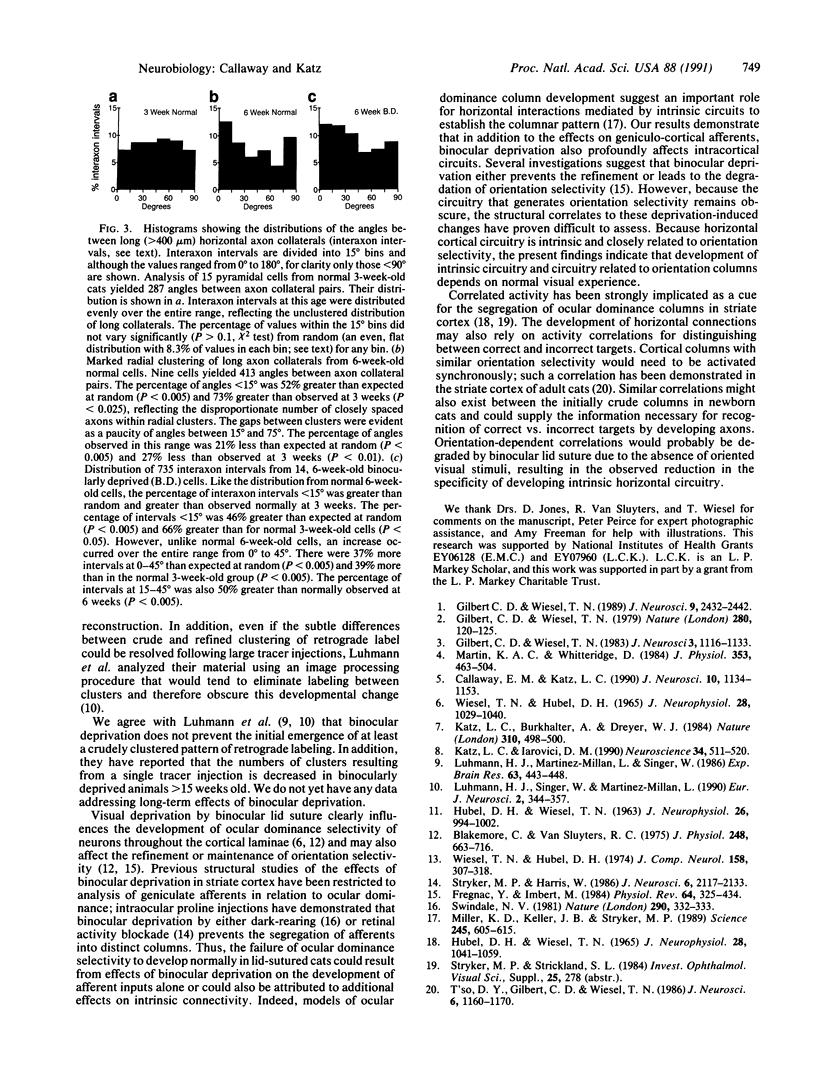
Images in this article
Selected References
These references are in PubMed. This may not be the complete list of references from this article.
- Blakemore C., Van Sluyters R. C. Innate and environmental factors in the development of the kitten's visual cortex. J Physiol. 1975 Jul;248(3):663–716. doi: 10.1113/jphysiol.1975.sp010995. [DOI] [PMC free article] [PubMed] [Google Scholar]
- Callaway E. M., Katz L. C. Emergence and refinement of clustered horizontal connections in cat striate cortex. J Neurosci. 1990 Apr;10(4):1134–1153. doi: 10.1523/JNEUROSCI.10-04-01134.1990. [DOI] [PMC free article] [PubMed] [Google Scholar]
- Frégnac Y., Imbert M. Development of neuronal selectivity in primary visual cortex of cat. Physiol Rev. 1984 Jan;64(1):325–434. doi: 10.1152/physrev.1984.64.1.325. [DOI] [PubMed] [Google Scholar]
- Gilbert C. D., Wiesel T. N. Clustered intrinsic connections in cat visual cortex. J Neurosci. 1983 May;3(5):1116–1133. doi: 10.1523/JNEUROSCI.03-05-01116.1983. [DOI] [PMC free article] [PubMed] [Google Scholar]
- Gilbert C. D., Wiesel T. N. Columnar specificity of intrinsic horizontal and corticocortical connections in cat visual cortex. J Neurosci. 1989 Jul;9(7):2432–2442. doi: 10.1523/JNEUROSCI.09-07-02432.1989. [DOI] [PMC free article] [PubMed] [Google Scholar]
- Gilbert C. D., Wiesel T. N. Morphology and intracortical projections of functionally characterised neurones in the cat visual cortex. Nature. 1979 Jul 12;280(5718):120–125. doi: 10.1038/280120a0. [DOI] [PubMed] [Google Scholar]
- HUBEL D. H., WIESEL T. N. RECEPTIVE FIELDS OF CELLS IN STRIATE CORTEX OF VERY YOUNG, VISUALLY INEXPERIENCED KITTENS. J Neurophysiol. 1963 Nov;26:994–1002. doi: 10.1152/jn.1963.26.6.994. [DOI] [PubMed] [Google Scholar]
- Hubel D. H., Wiesel T. N. Binocular interaction in striate cortex of kittens reared with artificial squint. J Neurophysiol. 1965 Nov;28(6):1041–1059. doi: 10.1152/jn.1965.28.6.1041. [DOI] [PubMed] [Google Scholar]
- Katz L. C., Burkhalter A., Dreyer W. J. Fluorescent latex microspheres as a retrograde neuronal marker for in vivo and in vitro studies of visual cortex. Nature. 1984 Aug 9;310(5977):498–500. doi: 10.1038/310498a0. [DOI] [PubMed] [Google Scholar]
- Katz L. C., Iarovici D. M. Green fluorescent latex microspheres: a new retrograde tracer. Neuroscience. 1990;34(2):511–520. doi: 10.1016/0306-4522(90)90159-2. [DOI] [PubMed] [Google Scholar]
- Luhmann H. J., Martínez Millán L., Singer W. Development of horizontal intrinsic connections in cat striate cortex. Exp Brain Res. 1986;63(2):443–448. doi: 10.1007/BF00236865. [DOI] [PubMed] [Google Scholar]
- Luhmann H. J., Singer W., Martínez-Millán L. Horizontal Interactions in Cat Striate Cortex: I. Anatomical Substrate and Postnatal Development. Eur J Neurosci. 1990;2(4):344–357. doi: 10.1111/j.1460-9568.1990.tb00426.x. [DOI] [PubMed] [Google Scholar]
- Martin K. A., Whitteridge D. Form, function and intracortical projections of spiny neurones in the striate visual cortex of the cat. J Physiol. 1984 Aug;353:463–504. doi: 10.1113/jphysiol.1984.sp015347. [DOI] [PMC free article] [PubMed] [Google Scholar]
- Miller K. D., Keller J. B., Stryker M. P. Ocular dominance column development: analysis and simulation. Science. 1989 Aug 11;245(4918):605–615. doi: 10.1126/science.2762813. [DOI] [PubMed] [Google Scholar]
- Stryker M. P., Harris W. A. Binocular impulse blockade prevents the formation of ocular dominance columns in cat visual cortex. J Neurosci. 1986 Aug;6(8):2117–2133. doi: 10.1523/JNEUROSCI.06-08-02117.1986. [DOI] [PMC free article] [PubMed] [Google Scholar]
- Swindale N. V. Absence of ocular dominance patches in dark-reared cats. Nature. 1981 Mar 26;290(5804):332–333. doi: 10.1038/290332a0. [DOI] [PubMed] [Google Scholar]
- Ts'o D. Y., Gilbert C. D., Wiesel T. N. Relationships between horizontal interactions and functional architecture in cat striate cortex as revealed by cross-correlation analysis. J Neurosci. 1986 Apr;6(4):1160–1170. doi: 10.1523/JNEUROSCI.06-04-01160.1986. [DOI] [PMC free article] [PubMed] [Google Scholar]
- Wiesel T. N., Hubel D. H. Comparison of the effects of unilateral and bilateral eye closure on cortical unit responses in kittens. J Neurophysiol. 1965 Nov;28(6):1029–1040. doi: 10.1152/jn.1965.28.6.1029. [DOI] [PubMed] [Google Scholar]
- Wiesel T. N., Hubel D. H. Ordered arrangement of orientation columns in monkeys lacking visual experience. J Comp Neurol. 1974 Dec 1;158(3):307–318. doi: 10.1002/cne.901580306. [DOI] [PubMed] [Google Scholar]



